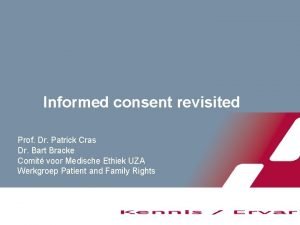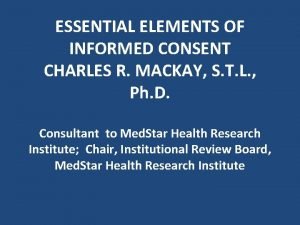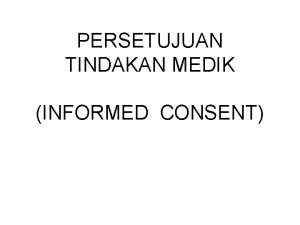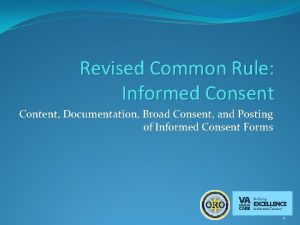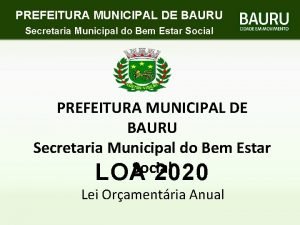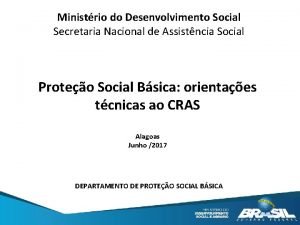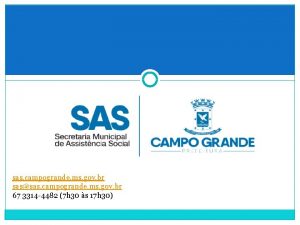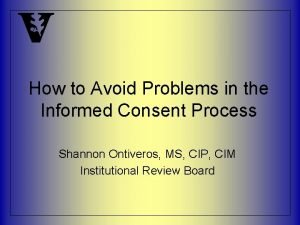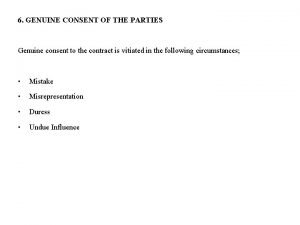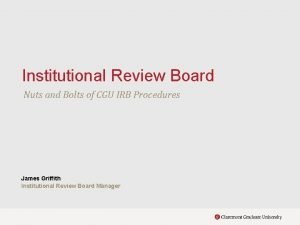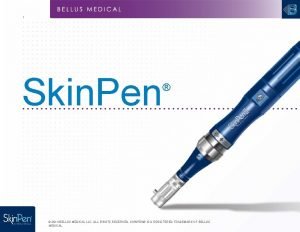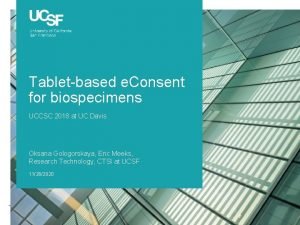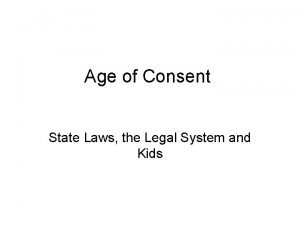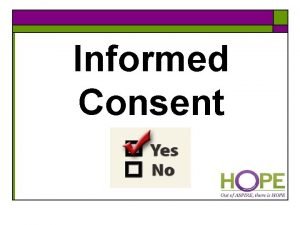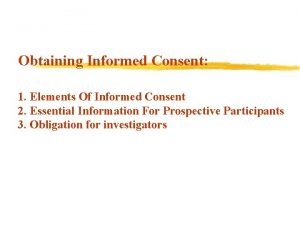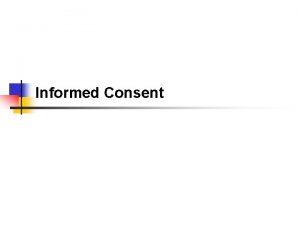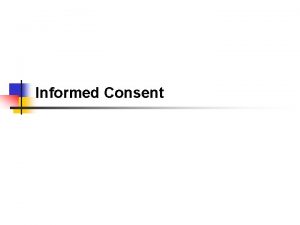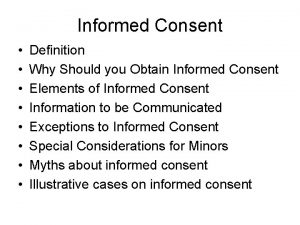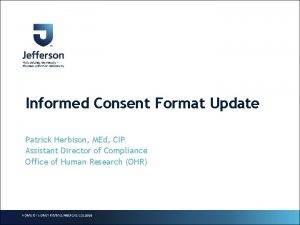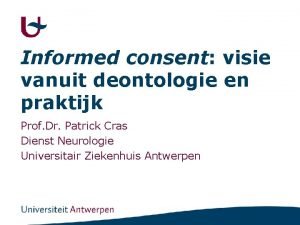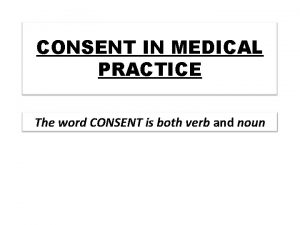Informed consent revisited Prof Dr Patrick Cras Dr












































- Slides: 44

Informed consent revisited Prof. Dr. Patrick Cras Dr. Bart Bracke Comité voor Medische Ethiek UZA Werkgroep Patient and Family Rights

What is informed consent? Informed consent is the process by which the treating health care provider discloses appropriate information to a competent patient so that the patient may make a voluntary choice to accept or refuse treatment (Appelbaum, 2007) It originates from the legal and ethical right the patient has to direct what happens to her body and from the ethical duty of the physician to involve the patient in his health care. The following will only deal with ‘routine’ health care…

Emanuel, 2005

Implicit informed consent • Consulting a dentist with tooth pain • Presenting with wound or fracture at ER • Blood donor presenting at donation center From the circumstances it can be concluded that the patient/person (silently) agrees with consequent health care act

Implicit versus explicit informed consent Implicit informed consent • Attend hospital to receive health care • Voluntarily providing information • Behavior shows intent to consent Explicit informed consent • Required for most interventions • Most frequently verbal, sometimes written • Is written in some circumstances abortion, transplantation, esthetic surgery

Informed consent • Presumed informed consent • Absence of refusal • Implicit informed consent (‘opting out’ procedure) • ‘Blanket’, ‘general’ or ‘open’ informed consent • General consent for a range of procedures • Context of sample donation of research • Less applicable in health care • Delayed consent (‘deferred consent’) • In emergent conditions • Patient or representative confirm asap • Proxy consent • Patient incompetent, legal representative consents

Who obtains informed consent? • Health care worker intending to perform intervention • Proportionality and expertise • Example: who obtains informed consent for a diagnostic intervention? Physician making indication Physician performing

Competence • Bill of patient rights does not clarify when patient is incompetent • Two dimensions of competence involve ‘understanding’ and ‘judgement’ • To what extent is patient able to understand concrete and abstract situations and able to decide in contiguity with generally accepted norms • Assessment of competence is delicate and it is unclear who is best suited to decide • In case of doubt ask physician/psychiatrist with expertise in assessing competence

Informed consent procedure @ UZA • Policy on informed consent according to Belgian legislation and JCI standards • Implicit informed consent for many health care interventions, explicit verbal consent for minimally invasive procedures and explicit documented informed consent for surgery and invasive procedures including those who legally require written informed consent • Health care worker allowed to be more strict • Straightforward and uniform, information provided according to departmental policies, consent part documented in C 2 M (demo) • Uses terminology as provided in BPR • For diagnostic procedures shared responsibility • For research: dealt with separately, not todays topic

Informed consent- JCI standards 5 th edition

Informed consent- JCI standards 5 th edition

Informed consent- JCI standards 5 th edition

What is a valid informed consent? Beauchamp and Childress set out seven elements of informed consent: 1. patient competence 2. disclosure of relevant information 3. patient understanding of that information 4. doctor’s recommended course of action 5. voluntariness of the decision 6. patient decision 7. formal authorisation of the plan • criticised for being extremely difficult to attain in practice • difficulties are amplified in the ICU setting …

How much information should be provided? • Reasonable physician standard: what would a typical physician state about this intervention? This standard allows the physician to determine what information is appropriate to disclose. • Reasonable patient standard: what would the average patient need to know in order to be an informed participant in the decision? • Subjective standard: what would this particular patient need to know and understand in order to make an informed decision?

The rule and the exceptions • Rule: explicit informed consent • ü ü Consent by patient advocate ü Emergent interventions: if advanced directives then binding, if not or Exceptions inconsistent act in best Implicit informed consent interest of patient Waiver of informed consent ü Act in best interest of Legal representative or patient (art. 8 § 5 BPR): assigned patient or representative gives consent post factum – – ‘proxy consent’ ‘delayed informed consent’ ü Proxy consent standard in pediatric health care

Issues characteristic of intensive care • • Incompetence of patients Proxy consent for ICU procedures Legal representative not always evident Procedures unfamiliar to patient and family over a number of weeks Overwhelmed by abundance of information Insufficient understanding of procedures Obtaining informed consent extremely time-consuming for ICU clinicians Emphasis on procedures detrimental to communication on status, therapeutic plan and prognosis

“ICU procedural consent is specifically about invasive procedures performed at the ICU bedside, including airway interventions, vascular access procedures, diagnostic and therapeutic aspirates and some endoscopic procedures” non-emergency ICU procedures versus time-critical procedures “The distinction between time-critical and non-timecritical procedures is difficult to establish in the setting of critical illness, but many ICU procedures are not so time-critical as to preclude discussion with the patient or family. ”

Modra et al. “For many years it was accepted that when a patient was admitted to the intensive care unit for treatment, they had implicitly consented to any procedures necessary for the delivery of intensive care. “ “A robust ICU procedural consent process must accommodate ICU limitations, rather than simply transposing the familiar model of informed consent for elective surgery to the critical care environment. “

How often is informed consent obtained? • Depends on procedure and context • Variability in verbal versus written consent • “it is also possible that a different aura attends certain procedures that compel clinicians to make greater efforts to obtain consent” (Davis, 2003) • Reported rate of proxy consent 65. 6 -73%

Pediatric intensive care • Prospective, observational and survey-based exploratory study in a single-center, tertiary care, university-affiliated PICU • 50 bedside procedures (only 1 st included N=41) – 14 days • IC not obtained for two emergent procedures • Consent was obtained in person in 33 cases (80%) and over the phone for the remainder • 96% of parents correctly recalled what procedure had been performed, and 92% correctly recalled at least one reason for the procedure, but only 58% recalled at least one risk of the procedure • Median reported duration of the informed consent discussion was 5 mins Pediatr Crit Care Med. 2011 Nov; 12(6): e 266 -70

Universal consent protocol (UCP) • For commonly practiced procedures • Central venous catheter, intubation, … • Tracheostomy, endoscopy and PEG tubes usually excluded • Patients and/or family members can consent to all the stated procedures, or consent to some but request specific discussion before nominated procedures, or not sign the consent form • Improved overall procedural consent rates without reducing the consenter’s understanding of the procedures

How is informed consent obtained? Implicit versus explicit informed consent Arguments in favor Greater understanding and dialogue Involvement of patients and families Vulnerable patients Unfamiliar rotating consultants Medicolegal Arguments against Implied emergency consent Leads to conflict Choice is an ‘empty’ one Negotations can be counterproductive Focus on procedures instead of prognosis and overall treatment Cultural

Informed consent for blood transfusion • Blood transfusion is a common intervention in the hospital setting • Patients unsure of indication for transfusion • Separate informed consent required by JCI standards, valid for 2 years • Some patients have religious objections to transfusion • Concern about well publicised but now extremely low risk of HIV or viral hepatitis transmission • Benefits tend to be overstated, risks understated, few ask questions • Inappropriate belief it is a high-risk treatment because of separate consent process Friedman, Am J Clin Pathol 2012; 138: 559 -565

In summary • Informed consent is a well established procedure promoting individual autonomy in health care, also in intensive care context • Obligations of health care workers to promote patient autonomy • Informed consent in ICU – PICU – NICU faces challenges • Should not be detrimental to patient, parent and proxy contacts • Universal consent protocol with modifications

QUESTIONS AND ANSWERS… DEMO OF INFORMED CONSENT DOCUMENTATION

Praktische demo Informed Consent

Informed Consent Mondelinge toestemming: • Documenteren van informatie en toestemming in C 2 m • in het bijzijn van de patiënt • Handtekenen door patiënt is dus niet nodig • OPMERKING: Wanneer een onderdeel niet van toepassing is: ‘niet van toepassing’ aanvinken

Schriftelijk (getekend) Informed Consent In geval van? • zwangerschapsonderbreking na 12 weken • orgaandonatie door levende donor met het oog op transplantatie • weefsel- en cellendonatie door levende donor met het oog op transplantatie • procedures in kader van reproductieve geneeskunde • procedure in kader van esthetische geneeskunde • experiment (zoals bedoeld in de wet van 7 mei 2004) Wat? • registratie door aanvinken • schriftelijk handtekenen

Informed Consent – Praktisch - C 2 m tab IC

Informed Consent - Praktisch • Stap 1: • Informed Consent Gynaecologie-Fertiliteit • Informed Consent Transplantatie

Informed Consent - Praktisch • Stap 2: Beschrijving Titel verschillende procedures Bv dienst ATH: • IC Hepatectomie • IC Cholecystectomie • IC Pancreatectomie • IC Thyroïdectomie • Op te stellen door/voor iedere dienst • De specifiek geïnformeerde toestemming voor een hepatectomie wordt dan opgeslagen • blijft zichtbaar in de rubriek geïnformeerde toestemming met als naam “hepatectomie”, • op de datum van invoering

Informed Consent - Praktisch • Stap 3: Standaard = Toestemming door patiënt zelf De keuze wettelijke vertegenwoordiger is mogelijk.

Informed Consent – Praktisch – wettelijke vertegenwoordiger

Informed Consent - Praktisch Automatisch wordt vanuit C 2 m in formulier ingevuld: • Datum van specifiek geïnformeerde toestemming • Naam-voornaam-geboortedatum van de patiënt • Naam-voornaam van de arts of gemandateerd zorgverlener die onder zijn/haar naam ingelogd is in C 2 m en die de specifiek geïnformeerd toestemming afneemt Stap 4: • Gegevens van de behandelende arts (steeds UZA-specialist) moeten handmatig ingevoerd worden

Informed Consent - Praktisch

Informed Consent - Praktisch Stap 5: aanvinken van mogelijke deelrubrieken Informed Consent Gynaecologie-Fertiliteit Informed Consent Transplantatie • Meerdere deelrubrieken aanvinken kan • Later aanvinken kan ook (bv. bij pre-op consultatie anaesthesie) • Pas na aanvinken van een deelrubriek, zullen de informatiepunten en de vraag naar toestemming uitgerold worden

Informed Consent - Praktisch

Informed Consent Gynaecologie-Fertiliteit - Praktisch

Informed Consent Gynaecologie-Fertiliteit - Praktisch

Informed Consent Gynaecologie-Fertiliteit - Praktisch

Informed Consent Transplantatie - Praktisch

Informed Consent Transplantatie - Praktisch

Informed Consent - Praktisch Stap 6: Valideren

Informed Consent • U heeft de nodige informatie over informed consent ontvangen • Ik geeft de toestemming aan de artsen van het UZA om het informed consent op al uw patiënten toe te passen en te documenteren zoals getoond • U bent nu in de gelegenheid om vragen te stellen
 Dr cras
Dr cras Random sampling over joins revisited
Random sampling over joins revisited Straight line motion revisited homework
Straight line motion revisited homework Informed consent brochure
Informed consent brochure Ethical principles governing informed consent process
Ethical principles governing informed consent process Essential elements of informed consent
Essential elements of informed consent 22power dot com
22power dot com Advantages of informed consent
Advantages of informed consent Undang undang persetujuan tindakan kedokteran
Undang undang persetujuan tindakan kedokteran Broad informed consent
Broad informed consent Http informed delivery usps
Http informed delivery usps Pervigilium veneris testo
Pervigilium veneris testo Cras ferradura mirim
Cras ferradura mirim Cras
Cras Cras
Cras Sindrom bywaters
Sindrom bywaters Liberae sunt nostrae cogitationes
Liberae sunt nostrae cogitationes Cras estrela do sul
Cras estrela do sul Bala debi vs majumdar
Bala debi vs majumdar Strategic context
Strategic context Age of consent la
Age of consent la Health care consent act hierarchy
Health care consent act hierarchy Implicit consent
Implicit consent Ib psychology ia consent form
Ib psychology ia consent form Consent
Consent What is sexual coersion
What is sexual coersion The consent elaine kaye
The consent elaine kaye Genuine consent
Genuine consent Assent vs consent
Assent vs consent Stanford prison experiment consent form
Stanford prison experiment consent form Cvs generic epipen
Cvs generic epipen Legal consent forms for veterinary practices
Legal consent forms for veterinary practices Consent statistics
Consent statistics Voluntary consent meaning
Voluntary consent meaning Skin pen consent form
Skin pen consent form Continuous consent
Continuous consent Ey2 declaration and consent form
Ey2 declaration and consent form Florida consent decree summary
Florida consent decree summary Dfps medical consent training
Dfps medical consent training Ic pvusd
Ic pvusd E consent pro
E consent pro The consent elaine kaye
The consent elaine kaye Minority consent dalam sosiologi adalah
Minority consent dalam sosiologi adalah Age of consent kentucky
Age of consent kentucky Infinitive and gerund phrases
Infinitive and gerund phrases
